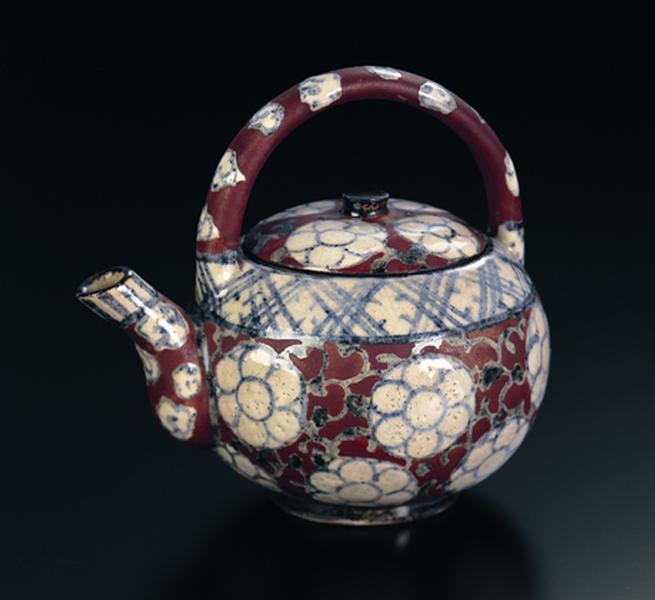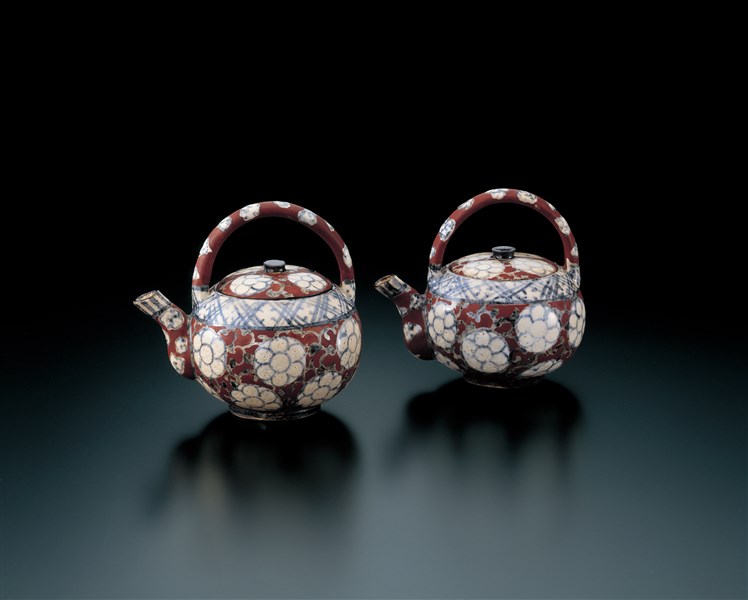Sauce Pots with Handles and Cloud and Chrysanthemum Design
- Edo period
- 18c
- Kenzan ware, high-fired pottery, overglaze enamels
- H-10.4 D-8.6 W-10.7
Sauce Pots with Handles and Cloud and Chrysanthemum Design
Sauce Pots with Handles and Cloud and Chrysanthemum Design
Kenzan ware works in the form of ewers with handles include large teapot-like pieces such as the Ewer with Arabesques in Overglaze Enamels in the collection of Myohoji temple in Tokyo and small sauce servers such as these. These are the same form as the sauce pots shown earlier (cat. nos. 20 and 21), with handles added. Other examples of sauce pots with handles include a set of five with lotus motifs (Itsuo Art Museum, Osaka). Even without handles, these sauce pots required craftsmen with the finest skills in forming and firing ceramics. The addition of a handle raises the technical bar even higher.
Their plump bodies and lids were delicately wheel formed and the handles and spouts added afterwards. Each pot was covered with white slip and elaborately decorated: underglaze iron is used for the Ouchi diamond motif on the band around the mouth, the chrysanthemum and plant scrolling motifs on the body and lid, the cloud motifs on the spout and handle and the band of stripes around the mouth of the spout. After application of a translucent glaze and the glaze firing, overglaze red pigments were applied. Wax may have been applied over the botanical scrolling motifs in the application of the red pigment, to make the red overglaze stand out.
The unglazed base reveals a fine-textured, somewhat brittle clay. The tanzaku-shaped framed Kenzan signature is painted in underglaze iron, without a white slip base. Examples of Kenzan ware with the Ouchi diamond in a band at the mouth include the Myohoji ewer and a tea bowl in the Metropolitan Museum of Art in New York. Shards with a similar motif have been unearthed at the Narutaki kiln site. The red color used in the overglaze is similar to that in a bowl with cloud and chrysanthemum motifs and the character for longevity in a private collection. These may have been creative variations on exotic examples from China and other countries. The Kenzan signature matches the one found on Nijo Chojiyamachi period works such as the Lidded Bowl with Silver Grass Design (cat. no. 11); these sauce pots may date from the same period.
These sauce pots come with a box of a type that suggests they were originally a pair. It is said that they were once separated, then reunited, and restored to their original box. While they are almost identical, close inspection reveals slight differences in form and placement of motifs. Perhaps Kenzan is inviting us to decide which is more exquisite - or which we like better.

